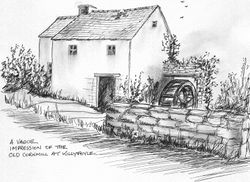Killyfole Mill

If you were born after 1970 you will have no memories of the old cornmill at Killyfole. It seems very sad that it is no longer there where it had stood for nearly 200 years. A chunk of local history erased and surely we are all the poorer for it.
In it's time the corn mill had an important function in rural Ireland when self sufficiency was the order of the day. Home produced oats provided food for animals, and after grinding in the mill, meal for porridge and oaten bread for the people. A healthy if somewhat monotonous diet! The mid to late 1700's saw a great surge in the use of water power and mills flourished along the rivers and streams all over Ireland and our area was no exception. We are able to find some information about the mills of this area from the tax records and valuation records held by government over the years. W.E.Hogg has produced a book on the Millers and Mills of Ireland of about 1850 which lists some useful information on the local scene at that time.
The mill at Killyfole around 1850 was owned by a Joseph Johnston and is listed as Cornmill Kilns and Land amounting to 29 acres 2 roods; Valuation of 33. Also living in Killyfole at that time were Fran Maguire, John Kellegher, John Killen and Thomas McCaffery. There were probably several small houses in the townland, which have long disappeared and some of these folk may have worked in the mill at busy times. Possibly the cottage that stood on the Lisnaskea side of the crossroads and was lived in by the McCabe family some 60 years ago was the last of these dwellings. It was known as the kilnman's house but little trace of it remains. Also listed at this time is the Cornmill Kiln and Land with 15 acres at Mullans belonging to Peter Lynch while at Rosslea a Benjamin Whitsitt had a mill and 30 acres. At Tattinbar there was a flax mill owned by John Madden and Madden and Whitsitt also had a corn mill and miller's house at Corraleek. All of these had a lower valuation than the mill at Killyfole.
It is difficult to transport one's mind back to how this area functioned in the 1850's. The country had just endured an awful famine. The fastest transport was the rate a horse could travel. It is likely that the oats were sown by hand, cut with a scythe or sickle, threshed with a flail, winnowed to get rid of the chaff and brought to the mill by cart or slung on the back of a donkey. There it would be dried in the kiln and ground into meal. There must have been a lot of grain grown to keep the fairly high number of mills working. Indeed at this time on one year 15,000 barrels of corn were sold in Cootehill to be ground into meal and exported through Dundalk to the growing industrial centres of Liverpool and Glasgow.
There are a few other mills we should mention making use of water power. At Tonity Bog, John McMahon held 23 acres and had a Cornmill Kiln and Spade mill. Older people will remember the Shannock spade which was made famous throughout Ireland by the expertise of the McMahon family and the manufacture of which was thriving in the first half of the 20th century. Unfortunately times changed and this venture came to an end.
The place with the highest property valuation belonged to John Hamilton at Mullynavannoge who had a cornmill and kiln and 100 acres of land, clearly quite a prosperous set-up for the time. Other fairly local mills listed under the old parishes of Galloon and Aghalucher included an Ellen Little with a cornmill and kiln at Keeran Beg and a Frances Skelton with similar premises at Donagh. Other mills are listed at Corralongford, Attyclannabryan, Cooneen, Cushwash, and Knocks.
At Cooneen and Curraghfad, Robert Whitely and Johnston McKeown had tuck mills. These mills were to scour and felt the woollen cloth made on hand looms in the cottages of the day. It is another indication of how self sufficient people had to be at this time and a few sheep must have been kept by lots of people to provide wool to make their own clothes.
As patterns of agriculture changed and new sources of power were developed the picturesque water mills by the side of the stream fell into disuse. Cheap imported grain from the great prairies of America became available and by the end of the first world war the local mill was in trouble. Some struggled on for a time but the era of water power was over for a while. It is only to-day, after a lapse of almost a century, that water is being recognised as a source of sustainable energy and is once more back in favour. Any old mills that were fortunate enough to survive are being restored. Often by community groups like our own, and given a new lease of life so that everyone can appreciate the technology of yesterday.
By Roy Murray